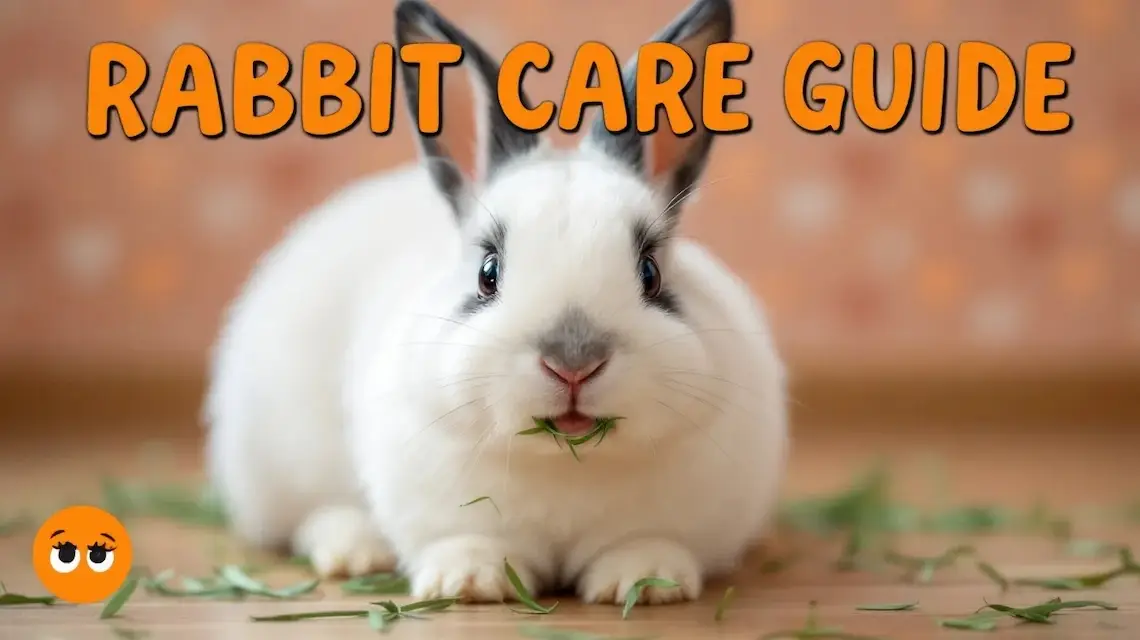Wondering how to take care of a rabbit without turning pet care into a full-time job? Rabbits can be low-maintenance day to day, yet they are affectionate, curious, and full of charm. With the right setup and routine, you get a sweet companion that fits real life.
This guide walks you through smart selection, housing that feels safe and roomy, a rabbit-friendly diet, basic health habits, and daily bonding. You will learn what to buy, how to set up space, what to feed, and how to read your rabbit’s behavior. Simple steps, clear routines, less guesswork.
Good care starts before you bring a rabbit home. Choose a healthy rabbit, plan a larger-than-you-think space, and set up time for exercise. Add hay, fresh greens, and clean water, then keep nails, teeth, and litter on a regular schedule.
Rabbits can live 8 to 12 years, so your choices matter. A calm home, gentle handling, and daily play build trust and cut stress. Follow the basics in this post, and you will help your rabbit live a long, happy life while keeping care simple and kind.
Choosing the Perfect Rabbit Breed for Your Family
The right rabbit should fit your home, your schedule, and your energy. Size, grooming, and personality vary a lot by breed. Match the rabbit to your lifestyle, and you prevent stress, biting, and boredom. If you want to learn how to take care of a rabbit without daily battles, start with a breed that suits your family.
Popular Rabbit Breeds and Their Unique Traits
Use this quick guide to compare size, temperament, and care needs. It will help you narrow the best rabbit breeds for beginners and for families with kids or other pets.
| Breed | Adult Size | Temperament | Care Level | Best For |
|---|---|---|---|---|
| Netherland Dwarf | 1–2.5 lb | Lively, curious, can be shy at first | Moderate | Small spaces, experienced homes, patient handlers |
| Mini Rex | 3–4.5 lb | Calm, gentle, enjoys handling | Easy | First-time owners, families with older kids |
| Lionhead | 2.5–3.5 lb | Friendly, social, playful | Moderate | Homes that can keep up with grooming |
| Holland Lop | 3–4 lb | Affectionate, cuddly, steady | Easy | Beginners, apartments, gentle children |
| Rex | 7–10 lb | Even-tempered, laid-back | Moderate | Families wanting a mellow companion |
| Flemish Giant | 12–16+ lb | Sweet, patient, couch-buddy vibe | Moderate | Larger homes, adults or older children |
Quick notes that help decisions:
- Netherland Dwarf: Tiny body, big energy. They bond deeply, but their small size means they can be fragile with rough play. Good for quiet homes that enjoy interactive time.
- Mini Rex: Famous for plush fur and a calm nature. Weekly brushing and extra care during sheds keep that soft coat healthy. A great fit for beginners who want a relaxed rabbit.
- Lionhead: The mane is adorable. Plan for regular brushing around the head and rear to prevent mats. Social and bright, they love training and gentle play.
- Holland Lop: Often a top pick for families. They stay small, handle indoor life well, and usually enjoy cuddles. Keep diet steady to avoid weight gain.
- Rex: Velvety coat feels like suede. Grooming is simple most weeks, but be gentle and brush more often during molts to protect delicate fur.
- Flemish Giant: Calm and people-focused. They need floor space and strong flooring, plus steady handling and a bigger litter box. Great if you want a “big dog” vibe in rabbit form.
Tip for matching energy:
- Active homes: Netherland Dwarf, Lionhead.
- Calm homes: Mini Rex, Holland Lop, Rex.
- Roomy homes: Flemish Giant, Rex.
Adoption advice:
- Shelters and rescues often have mixed-breed rabbits with steady temperaments and known histories. Staff can match you with a rabbit that suits your space and routine.
- Responsible breeders should share health records, allow you to see living conditions, and discuss spay or neuter plans. Avoid impulse buys at stores with unclear sourcing.
Choosing a breed that suits your life reduces chewing, anxiety, and hiding. It also makes daily care smoother and helps your rabbit feel safe and content.
Key Factors to Consider Before Bringing a Rabbit Home
A smart plan saves money, time, and stress. Think through these points before you commit.
- Time and daily care: Plan for feeding, litter scooping, and at least 2 to 4 hours of out-of-enclosure exercise each day. Rabbits need play and interaction to stay healthy and happy.
- Annual cost: Expect about 500 to 1,000 dollars per year for hay, pellets, greens, litter, toys, and vet care. Set aside a fund for emergencies and dental checks.
- Space: Aim for an enclosure at least 4×4 feet, plus a larger play area. Bigger breeds need more room, sturdier flooring, and larger litter boxes.
- Allergies: Hay and dander can trigger symptoms. Spend time with rabbits and hay in advance. Consider low-shed times or HEPA filters if your home is allergy-prone.
- Kids and other pets: Choose tolerant breeds for families with children. Holland Lops and Mini Rex are often easier. Supervise all dog and cat interactions. Prey instincts can cause panic if introductions are rushed.
- Experience level: First-time owners do best with calm rabbits that accept handling. If you want the best rabbit breeds for beginners, start with Holland Lop or Mini Rex, or ask a rescue to suggest a mellow adult.
- Energy match: High-energy rabbits need more enrichment and training. If your schedule is tight, pick a calmer breed to prevent frustration on both sides.
- Health checks: Ask about age, diet history, and current weight. Request vet records. A rabbit that is already spayed or neutered usually settles faster, sprays less, and bonds more easily.
- Adopt or buy: Adoption supports ethical care and often includes spay or neuter at a lower cost. If buying, choose a breeder who socializes kits, provides references, and welcomes questions.
Why this prep matters:
- Less stress for you and the rabbit.
- Fewer behavior issues like chewing and scratching.
- Easier bonding because the environment fits the rabbit’s needs.
- Simpler routines that make how to take care of a rabbit feel manageable.
Write down your home’s limits and goals, then match a rabbit to that list. When the breed, space, and routine line up, you get a calm companion, smoother training, and a happier home.
Setting Up a Safe and Cozy Home for Your Rabbit
A safe, roomy setup is the heart of how to take care of a rabbit. Think comfort, freedom to move, and protection from injury and stress. The right space prevents escapes, supports litter habits, and stops chewing from turning into a disaster. Use these rabbit cage setup ideas to build a home that keeps your rabbit calm and content.
Choosing the Best Housing Options Indoors or Outdoors
Indoor housing is the best choice for safety and daily bonding. Go for spacious enclosures, not small cages. The minimum size is 4 feet by 2 feet by 2 feet for a small to medium rabbit. Bigger is better, especially for large breeds.
Great indoor options:
- Exercise pen: A 36 to 42 inch tall pen creates a roomy “bunny room” that is easy to clean and reconfigure. Add rugs for traction.
- Free-roam room: A bedroom or office can work if fully bunny-proofed. Use baby gates to limit access.
- C&C grids: Build custom layouts with solid flooring. They are sturdy and flexible.
Avoid wire floors. They hurt feet and cause sores. Use solid plastic, vinyl, or sealed wood with washable rugs or foam mats for grip.
Outdoor hutches can work in mild climates with strict safety, but indoor housing is safer. If you must house outdoors:
- Choose a raised, predator-proof hutch with locks on all doors.
- Add weather protection like insulation, wind breaks, and shade. Never place in direct sun.
- Provide a secure attached run with a roof and buried wire skirt to stop digging.
- Bring rabbits inside during heat, storms, and extreme cold. Predators, parasites, and weather make outdoor setups a higher risk, even with good gear.
Budget-friendly setup ideas, total 100 to 300 dollars:
- Exercise pen: 50 to 110
- Rug or foam mats: 20 to 50
- Litter box and pellets: 15 to 30
- Hide box and toys: 15 to 40
- Water bowl and food crock: 10 to 25
Essential Accessories for Comfort and Safety
Your rabbit needs more than walls and a floor. These items support health, ease stress, and prevent trouble.
- Hiding spot: Cardboard box, wooden house, or tunnel. Gives a safe retreat, lowers heart rate, and helps shy rabbits relax. Place at least one hide per rabbit.
- Chew toys: Apple sticks, willow balls, untreated pine blocks, hay mats. Chewing files teeth and prevents overgrowth. Rotate toys to beat boredom.
- Litter box: A large, low-entry box with paper-based pellets. Rabbits are naturally tidy, so place the box in the corner they pick. Add hay next to or inside the box to encourage use.
- Bedding materials: Use paper pellets, aspen shavings, or fleece liners over absorbent pads. Avoid cedar and pine since their oils can irritate the liver and airways.
- Secure fencing or gates: Tall exercise pens and baby gates create safe zones and prevent escapes. Look for bar spacing under 1.5 inches.
Enrichment keeps minds busy and stops destructive behavior:
- Forage games: Stuff hay with herbs in paper bags or toilet paper rolls.
- Dig box: Fill a shallow bin with shredded paper for digging fun.
- Climb and explore: Low platforms, ramps, and tunnels add movement.
Maintaining the Right Environment Temperature and Cleanliness
Rabbits handle cool air better than heat. Aim for 60 to 70°F indoors. Heat stress starts fast, so provide shade, airflow, and cool ceramic tiles in summer. Never place the enclosure near radiators or in direct sun.
Keep the air fresh without drafts. Open a window for gentle ventilation or use a fan across the room, not pointed at your rabbit. Good airflow lowers ammonia from urine and reduces respiratory issues.
Cleanliness keeps illness away and supports a longer life. Use this simple routine:
- Daily: Scoop litter, refresh hay and water, wipe wet spots. Toss soiled bedding.
- Weekly: Deep clean the enclosure, wash bowls, scrub litter boxes with warm water and white vinegar, then rinse and dry.
- Monthly: Inspect flooring, gates, and locks. Replace worn mats and frayed toys.
Bunny-proofing protects both your rabbit and your home:
- Hide or cover cords with cord protectors or PVC tubing.
- Remove toxic plants like lilies, philodendron, dieffenbachia, and pothos.
- Block tight spaces under couches and appliances.
- Store cleaning products and chemicals out of reach.
A steady, clean, and cool environment leads to better appetite, smoother litter habits, and stronger bonding. Pair that with daily play and you will have a safe home that supports health and happiness for years.
Feeding Your Rabbit a Nutritious Diet for Optimal Health
Food is the engine behind a rabbit’s mood, coat, and energy. A hay-first menu keeps digestion smooth, teeth in check, and weight stable. Use this rabbit feeding guide to set daily portions, prevent tummy trouble, and make how to take care of a rabbit feel simple and consistent.
Aim for 80 to 90 percent hay, with measured pellets and a variety of fresh greens. Make any change slowly, over 7 to 10 days, to protect the gut. If your rabbit has health issues or is underweight or overweight, ask a rabbit-savvy vet for a personalized plan.
Core Foods: Hay, Pellets, and Fresh Veggies
Hay is the foundation. For adult rabbits, offer unlimited timothy hay at all times. Orchard grass and meadow hay are fine alternatives. The rough fiber keeps the gut moving and the long strands force chewing, which files teeth and prevents overgrowth.
Pellets add balanced vitamins and minerals, but they should not crowd out hay.
- Pellet portion: about 1/4 cup per 5 pounds of body weight per day, plain timothy-based pellets with at least 18 percent fiber and no added seeds or colored bits.
Fresh greens bring water, micronutrients, and flavor. Rotate several options to keep meals interesting and balanced.
- Greens portion: about 1 cup per 2 pounds of body weight per day.
- Good picks: romaine, green leaf, red leaf, parsley, cilantro, basil, dill, fennel fronds, carrot tops.
- Introduce new greens slowly. Start with a few leaves, then increase if stool stays normal.
Seasonal tip for September and fall: take advantage of garden herbs and sturdy lettuces. Fresh parsley, cilantro, and romaine are often at their best. Rinse well, pat dry, and serve.
Why this balance matters:
- Hay-heavy diets support steady digestion and healthy cecotropes.
- Measured pellets prevent weight gain and lethargy.
- Varied greens add hydration and antioxidants that support a shiny coat and better energy.
Example day for a 5-pound adult:
- Unlimited timothy hay
- 1/4 cup plain timothy pellets
- 2.5 cups mixed leafy greens
Hydration Tips and Safe Treat Options
Clean water keeps the gut moving and kidneys happy. Offer water in a heavy ceramic bowl or a sipper bottle, or both, then change it daily. Many rabbits drink more from bowls because it is a natural head position.
Watch for dehydration, especially in summer or after a stress event:
- Red flags: small or dry droppings, tacky gums, low energy, not eating hay.
Treats help build trust, but keep them tiny. High sugar snacks can upset the gut and add pounds.
- Safe treats: thin apple slices, a few blueberries, or carrot tops.
- Portion: no more than 1 to 2 teaspoons per day total for fruits and sweet veg.
Better everyday “treats”:
- Fresh herbs like mint or dill
- Extra crunchy hay stalks
- Small willow sticks for chewing
Common Feeding Mistakes to Avoid
Some foods marketed for rabbits cause real harm. Skip these to protect your rabbit and your wallet.
- Seeds and mix-in pellets: High fat and choking risk. They displace hay and lead to obesity. Choose plain, uniform pellets instead.
- Yogurt drops: Dairy is not rabbit-friendly and can disrupt gut bacteria. Offer leafy herbs or a sliver of apple for training.
- Iceberg lettuce: Mostly water and can cause diarrhea. Pick romaine, green leaf, or butter lettuce instead.
- Too much fruit: Frequent sugar spikes strain the pancreas and can contribute to diabetes and GI upset. Keep fruit to tiny, occasional treats.
- Low hay intake: Without steady chewing, teeth overgrow, which can cause pain, drooling, and costly dental work. Keep hay fresh, plentiful, and in multiple spots.
Smart alternatives that keep rabbits healthy:
- Swap seed mixes for plain timothy pellets.
- Trade yogurt drops for herb sprigs or a blueberry.
- Replace iceberg with crisp romaine or parsley.
- Boost hay interest with small piles in several locations and hay stuffed in toys.
Prevention saves vet bills. A hay-based diet supports correct tooth wear, stable digestion, and steady weight. If your rabbit’s poops get smaller, your rabbit stops eating, or you see sudden weight change, contact a rabbit-savvy vet right away.
Quick daily reference:
| Item | Adult Portion | Notes |
|---|---|---|
| Hay | Unlimited | Timothy, orchard, or meadow; fresh piles daily |
| Pellets | 1/4 cup per 5 lb | Plain, high-fiber, no seeds |
| Leafy greens | 1 cup per 2 lb | Rotate varieties, introduce slowly |
| Treats | 1–2 tsp max | Fruit or carrot tops, not every day |
| Water | Fresh daily | Bowl, bottle, or both; monitor intake |
Feed with routine, watch the litter box, and adjust portions to maintain a lean, athletic shape. This balanced approach makes how to take care of a rabbit clear, kind, and sustainable for the long run.
Grooming, Health Checks, and Playtime Essentials
Good daily care keeps your rabbit comfortable, stress-free, and active. This section covers simple routines that prevent problems, build trust, and keep your rabbit moving. If you want to know how to take care of a rabbit with confidence, weave these habits into your week. They are practical rabbit health care tips that protect both body and mood.
Daily Grooming Routines to Keep Fur and Nails in Check
A light grooming routine stops mats, hair ingestion, and overgrown nails. It also trains your rabbit to enjoy gentle handling.
- Brush 2 to 3 times weekly: Use a soft slicker or rubber grooming brush. Short sessions catch loose fur and cut the risk of hair ingestion, especially during sheds.
- Tidy high-shed days: During heavy molts, brush daily. Offer a small herb treat to keep the experience positive.
- Trim nails monthly: Look for the quick, trim just ahead of it, and keep styptic powder nearby in case of a nick. If you are unsure, ask your vet or a trained groomer to show you once.
- Weekly checks: Ears, eyes, teeth, and skin.
- Ears should be clean and odor-free.
- Eyes should be bright with no discharge.
- Teeth should meet cleanly, with no drool or bumps along the jaw.
- Skin should be clear with no bald spots, dandruff, or sores.
- Make it fun: Pair handling with rewards. Touch feet, lift ears, and peek at teeth, then give a tiny herb or a blueberry. Short, calm reps beat long sessions.
Quick tip: Place a towel on your lap for better grip. Many rabbits settle when their back end is gently supported.
Recognizing Health Problems and When to See a Vet
Rabbits hide pain, so early signs matter. A fast response can save a life.
Watch for these red flags:
- Not eating or not pooping: Possible GI stasis, an emergency. Contact a rabbit-savvy vet now.
- Lethargy or hunching: Low energy, grinding teeth, or hiding can mean pain.
- Diarrhea or very soft stool: Dehydration risk and gut imbalance.
- Sudden fur loss or dandruff: Possible mites, fleas, or fungal issues.
- Runny eyes or nose, sneezing: Potential respiratory infection.
- Weight change, drool, or jaw swelling: Dental trouble is common and painful.
- Straining to urinate or red-tinged urine: Urinary issues need prompt care.
Preventive steps that pay off:
- Rabbit-savvy vet: Schedule checkups twice yearly. Rabbits age fast, and small issues can escalate.
- Spay or neuter: Reduces reproductive cancer risk by about 90 percent, lowers spraying, and helps behavior.
- Vaccinations: Ask your vet about RHDV2 vaccination where available. This virus can be fatal, and vaccines are increasingly offered in many regions.
- Parasite control: Indoor rabbits can still get mites or fleas. Get guidance before using any product.
Build a simple emergency kit:
- Digital thermometer, water-based lube, and a soft towel
- Oral syringes and a critical care formula for hand-feeding
- Nail clippers and styptic powder
- Saline, gauze, and small scissors
- Heating pad on low, placed under half the carrier
- Vet contact info, plus the nearest 24-hour clinic
When in doubt, call your vet. Quick action is the safest move with rabbits.
Fun Exercise and Socialization Ideas for Active Rabbits
Movement keeps joints healthy and minds sharp. It also prevents obesity and destructive chewing. Plan 3 to 4 hours of out-of-enclosure time daily in a bunny-proofed space.
Try these easy ideas:
- Tunnel courses: Link cardboard tunnels with boxes to create paths. Change the layout each week to spark curiosity.
- Forage play: Stuff hay into paper bags or stack hay in a willow ball. Hide a few herb sprigs inside.
- Chase and toss toys: Willow rings, straw mats, and light plastic baby keys add variety.
- Gentle agility: Low footstools, ramps, and soft rugs encourage hopping and climbing.
- Dig station: A shallow bin with shredded paper satisfies the urge to dig.
Social time builds trust and reduces stress:
- Short petting sessions: Start with head and cheeks. Stop while your rabbit is still engaged so they look forward to the next session.
- Floor-level bonding: Sit on the ground and let your rabbit approach you. Offer a tiny treat when they check in.
- Litter training for freedom: Place a large, low-entry box in the corner your rabbit uses most. Add hay next to the box to encourage use. Better litter habits mean more safe roaming time.
Benefits you will notice:
- Health: Lower weight, better digestion, stronger muscles.
- Behavior: Less chewing on furniture, more relaxed body language.
- Longevity: Active, engaged rabbits tend to live longer, happier lives.
If you ever feel stuck on how to take care of a rabbit with more enrichment, rotate toys weekly and change the play layout. Small changes turn a normal room into an adventure zone.
Conclusion
Caring for a rabbit starts with a smart match, then a calm routine. Choose a rabbit that fits your space and schedule, and set up a roomy, safe home. Keep a hay-first diet, fresh water, and simple greens. Add gentle grooming, regular nail trims, and checkups with a rabbit-savvy vet. Protect playtime, offer hides and chew toys, and keep the environment cool and clean.
Start with adoption if you can. Rescues know each rabbit’s personality, and they guide you through setup and bonding. Be patient in the first weeks. Quiet time, slow handling, and steady habits build trust.
If you are ready to learn how to take care of a rabbit with confidence, take your next step today. Reach out to a local rescue, set up your space, and plan your first hay order. Share your questions and wins in the comments, and help other readers learn from your experience.
A cared-for rabbit gives back in full. Gentle routines grow into a lasting bond and a happy, loving friend.
Related post:Can Cats Eat Bananas?
FAQ:
What should my rabbit eat every day?
Unlimited grass hay, fresh water, and a small amount of leafy greens. Offer 1 to 2 packed cups of greens per 6 pounds of body weight. Add a measured portion of plain, high-fiber pellets, about 1 tablespoon per 2 pounds. Treats should be rare.
Which vegetables and fruits are safe?
Safe greens include romaine, green leaf, red leaf, cilantro, parsley, dill, and basil. Rotate varieties. Limit high-oxalate greens like spinach and Swiss chard. Avoid iceberg. Fruits like apple slices, berries, or banana are fine in tiny amounts, a teaspoon or two.
How much hay is enough?
Hay should be available at all times. Most rabbits eat a pile as big as their body each day. Timothy, orchard, or meadow hay works best. Young rabbits can have alfalfa until 6 to 7 months, then switch to grass hay.
What housing does a rabbit need?
Use a roomy pen or free-roam space, not a small cage. Aim for at least 8 by 4 feet of exercise area, with more time out daily. Add a litter box, a hidey house, water bowl, hay rack, and chew toys.
Can rabbits be litter trained?
Yes. Place hay right next to or inside the litter box, since rabbits like to eat and poop together. Use paper-based or wood pellet litter. Avoid clay, clumping, or scented products. Scoop daily.
How do I groom my rabbit?
Brush weekly, daily during heavy sheds, to prevent hair ingestion. Trim nails every 4 to 8 weeks. Do not bathe rabbits. Spot clean dirty fur with a damp cloth and corn starch for mats.
How should I pick up and hold my rabbit?
Support the chest and hindquarters. Keep the body close to yours. Never lift by the ears or scruff. Many rabbits prefer sitting with you on the floor instead of being carried.
How much exercise do rabbits need?
At least 3 to 5 hours of safe, supervised time each day. Offer tunnels, cardboard boxes, dig boxes, and chew toys. Rotate toys to keep things interesting.
Do rabbits need a companion?
Most do best with another rabbit. Neutered pairs or trios can bond well. Introduce on neutral ground and go slow. If a match fails, try a different partner.
Should I spay or neuter my rabbit?
Yes. It reduces spraying and aggression, prevents uterine cancer in females, and helps with bonding and litter training. Most vets perform surgery once rabbits are sexually mature, often around 4 to 6 months.
What are signs my rabbit is sick?
Warning signs include not eating, small or no poop, bloating, tooth grinding, runny nose, head tilt, or sudden quiet behavior. If your rabbit stops eating or pooping, treat it as an emergency and call a rabbit-savvy vet.
What is GI stasis and what should I do?
GI stasis is when the gut slows or stops. It can be fatal. Signs include no appetite, tiny or no droppings, and lethargy. Seek immediate vet care. Do not wait it out.
Do rabbits need vaccines?
Ask your vet about RHDV2, a deadly virus in rabbits. Vaccines are available in many areas in the U.S. and required in some countries. Availability varies by state or region.
How do I keep my rabbit cool in summer?
Keep the room between 60 and 70°F if possible. Provide shade, airflow, and cool tiles. Freeze water bottles for them to lean on. Never leave a rabbit in a car. Watch for panting or drooling, which are heat stress signs.
How do I rabbit-proof my home?
Block access to wires with cord covers or conduit. Protect baseboards and furniture with barriers. Provide plenty of safe chew items so they pick those instead. Keep toxic plants and cleaning products out of reach.
What chew toys are safe?
Untreated willow, apple wood sticks, hay cubes, plain cardboard, and rabbit-safe wood blocks work well. Avoid painted or varnished wood and soft plastics that can be swallowed.
What litter should I use?
Paper-based litter, paper pellets, or hardwood stove pellets are good. Avoid clay, clumping, or silica litters. Do not use softwood shavings unless kiln-dried and used sparingly under a paper layer.
How do I care for my rabbit’s teeth?
Teeth grow nonstop. Constant hay chewing keeps them worn. Watch for drooling, dropping food, or picky eating, which can signal dental problems. Regular vet checks help catch issues early.
How long do rabbits live?
Most indoor rabbits live 8 to 12 years. Large breeds may have shorter lifespans. Good diet, housing, and vet care make a big difference.
What is normal rabbit poop?
Healthy poop is round, dry, and uniform. You will also see clusters of soft, shiny cecotropes, which rabbits eat for nutrients. A sudden change in size or number can signal a problem.
Can rabbits live outdoors?
Indoor housing is safer. Outdoor risks include heat, cold, predators, parasites, and disease. If outdoors at all, use a secure, predator-proof run and bring the rabbit inside during extreme weather.
Can rabbits live with dogs or cats?
Some do, with strict supervision and careful introductions. Prey drive is real. Your rabbit needs a safe zone the other pets cannot enter.
How do I travel with a rabbit?
Use a hard-sided carrier lined with a towel and hay. Keep the car cool and quiet. Offer water at stops. For flights, check airline rules and speak with your vet first.
How often should my rabbit see a vet?
Get a wellness exam once a year, twice for seniors. Choose a vet experienced with rabbits. Seek prompt care for appetite, poop, or behavior changes.
Is pet insurance worth it for rabbits?
It can help with unexpected costs, like dental or emergency care. Compare plans for coverage limits, waiting periods, and exclusions.
What bedding should I use?
Most rabbits do not need soft bedding across the whole pen. Use a nonslip mat or rug and place soft bedding only in the litter box or resting area. Avoid scented products.
How do I introduce a new rabbit?
Quarantine the newcomer for 2 weeks. Spay or neuter both rabbits first. Start short, neutral-territory sessions, side by side pens, and swap scents. Watch for chasing that escalates or biting.
Are baths ever okay?
No full baths. Rabbits chill easily and can panic. Spot clean messes. For stuck poop, use a shallow bum bath with lukewarm water and dry fully, then call your vet to check for causes.
What daily care should I do?
Refresh hay and water, scoop litter, and check appetite and poop. Do a quick body check for sore hocks, wet chin, or eye or nose discharge. Spend time with your rabbit so you notice changes fast.



 Dog Trick Training for Beginners
Dog Trick Training for Beginners  Gingivitis Cats Symptoms Every Pet Parent Should Know
Gingivitis Cats Symptoms Every Pet Parent Should Know  How to Make Dog Cookies at Home
How to Make Dog Cookies at Home  Wet Food or Dry Food for Cats?
Wet Food or Dry Food for Cats?  What Is the Healthiest Hamster Breed for Your Home?
What Is the Healthiest Hamster Breed for Your Home?  Cat Food Intolerance Symptoms: How To Spot Them Early
Cat Food Intolerance Symptoms: How To Spot Them Early